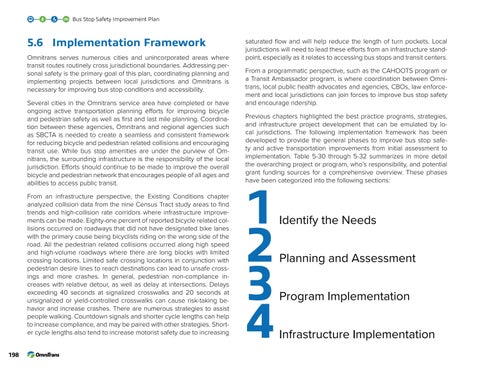Bus Stop Safety Improvement Plan
5.6 Implementation Framework Omnitrans serves numerous cities and unincorporated areas where transit routes routinely cross jurisdictional boundaries. Addressing personal safety is the primary goal of this plan, coordinating planning and implementing projects between local jurisdictions and Omnitrans is necessary for improving bus stop conditions and accessibility. Several cities in the Omnitrans service area have completed or have ongoing active transportation planning efforts for improving bicycle and pedestrian safety as well as first and last mile planning. Coordination between these agencies, Omnitrans and regional agencies such as SBCTA is needed to create a seamless and consistent framework for reducing bicycle and pedestrian related collisions and encouraging transit use. While bus stop amenities are under the purview of Omnitrans, the surrounding infrastructure is the responsibility of the local jurisdiction. Efforts should continue to be made to improve the overall bicycle and pedestrian network that encourages people of all ages and abilities to access public transit. From an infrastructure perspective, the Existing Conditions chapter analyzed collision data from the nine Census Tract study areas to find trends and high-collision rate corridors where infrastructure improvements can be made. Eighty-one percent of reported bicycle related collisions occurred on roadways that did not have designated bike lanes with the primary cause being bicyclists riding on the wrong side of the road. All the pedestrian related collisions occurred along high speed and high-volume roadways where there are long blocks with limited crossing locations. Limited safe crossing locations in conjunction with pedestrian desire lines to reach destinations can lead to unsafe crossings and more crashes. In general, pedestrian non-compliance increases with relative detour, as well as delay at intersections. Delays exceeding 40 seconds at signalized crosswalks and 20 seconds at unsignalized or yield-controlled crosswalks can cause risk-taking behavior and increase crashes. There are numerous strategies to assist people walking. Countdown signals and shorter cycle lengths can help to increase compliance, and may be paired with other strategies. Shorter cycle lengths also tend to increase motorist safety due to increasing 198
saturated flow and will help reduce the length of turn pockets. Local jurisdictions will need to lead these efforts from an infrastructure standpoint, especially as it relates to accessing bus stops and transit centers. From a programmatic perspective, such as the CAHOOTS program or a Transit Ambassador program, is where coordination between Omnitrans, local public health advocates and agencies, CBOs, law enforcement and local jurisdictions can join forces to improve bus stop safety and encourage ridership. Previous chapters highlighted the best practice programs, strategies, and infrastructure project development that can be emulated by local jurisdictions. The following implementation framework has been developed to provide the general phases to improve bus stop safety and active transportation improvements from initial assessment to implementation. Table 5-30 through 5-32 summarizes in more detail the overarching project or program, who’s responsibility, and potential grant funding sources for a comprehensive overview. These phases have been categorized into the following sections:
1 2 3 4
Identify the Needs Planning and Assessment Program Implementation Infrastructure Implementation



















































